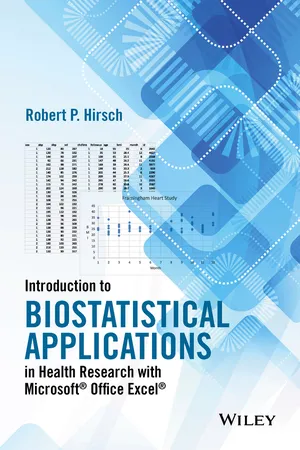
Introduction to Biostatistical Applications in Health Research with Microsoft Office Excel
- English
- ePUB (mobile friendly)
- Available on iOS & Android
Introduction to Biostatistical Applications in Health Research with Microsoft Office Excel
About This Book
A practical and methodological approach to the statistical logic of biostatistics in the field of health research
Focusing on a basic understanding of the methods and analyses in health research, Introduction to Biostatistical Applications in Health Research with Microsoft® Office Excel® provides statistical concepts for interpreting results using Excel. The book emphasizes the application of methods and presents the most common methodological procedures in health research, which includes multiple regression, ANOVA, ANCOVA, logistic regression, Cox regression, stratified analysis, life table analysis, and nonparametric parallels.
The book is constructed around a flowchart that outlines the appropriate circumstances for selecting a method to analyze a specific set of data. Beginning with an introduction to the foundational methods of statistical logic before moving on to more complex methods, Introduction to Biostatistical Applications in Health Research with Microsoft® Office Excel® also includes:
- Detailed discussions of how knowledge and skills in health research have been integrated with biostatistical methods
- Numerous examples with clear explanations that use mostly real-world health research data in order to provide a better understanding of the practical applications
- Implements Excel graphic representations throughout to help readers evaluate and analyze individual results
- An appendix with basic information on how to use Excel
- A companion website with additional Excel files, data sets, and homework problems as well as an Instructor's Solutions Manual
Introduction to Biostatistical Applications in Health Research with Microsoft® Office Excel® is an excellent textbook for upper-undergraduate and graduate-level courses in biostatistics and public health. In addition, the book is an appropriate reference for both health researchers and professionals.
Frequently asked questions
Information
Part One
Basic Concepts
Table of contents
- Cover
- Title Page
- Copyright
- Preface
- Acknowledgments
- Notices
- About the Companion Website
- Part One: Basic Concepts
- Part Two: Univariable Analyses
- Part Three: Bivariable Analyses
- Part Four: Multivariable Analyses
- Appendix A: Flowcharts
- Appendix B: Statistical Tables
- Appendix C: Standard Distributions
- Appendix D: Excel Primer
- Index
- End User License Agreement